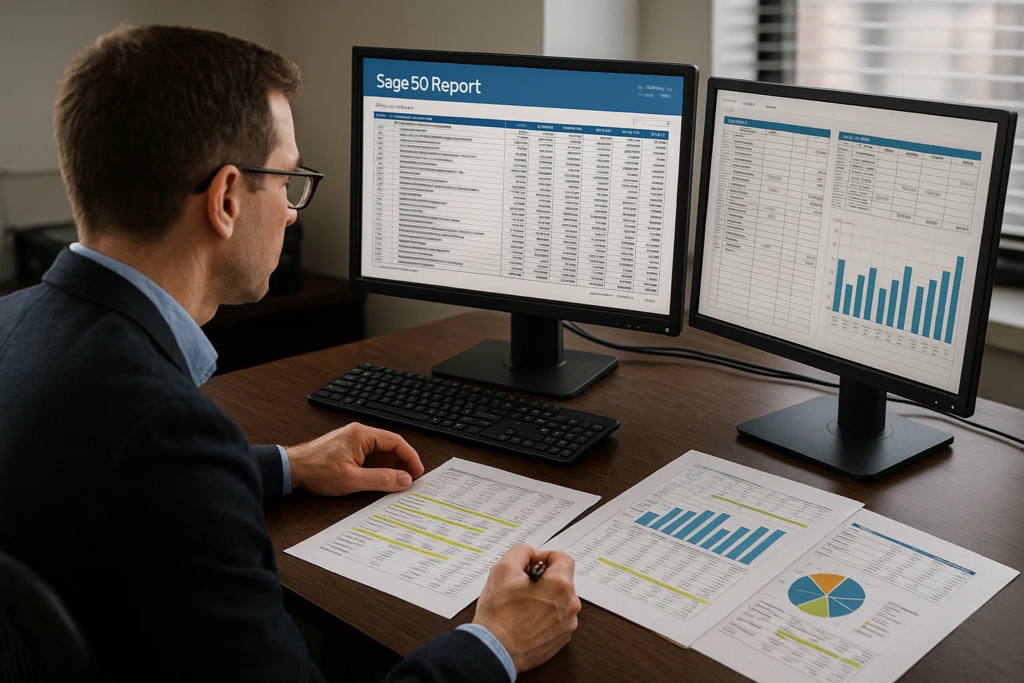

Managing your business finances can feel overwhelming, especially when your accounting software presents unexpected hurdles. Without addressing these challenges, your productivity suffers, data accuracy becomes compromised, and financial decision-making is hindered. By identifying common Sage 50 issues and implementing proven solutions, you can transform potential roadblocks into stepping stones for greater efficiency and accuracy.
Sage 50, formerly known as Peachtree Accounting, stands as a trusted accounting solution for small and medium-sized businesses worldwide. With robust features for financial management, invoicing, inventory tracking, and reporting, it’s designed to streamline your accounting processes. However, like any sophisticated software, users may encounter challenges that can impede workflow and efficiency. This comprehensive guide will walk you through the most common Sage 50 challenges and provide practical solutions to overcome them.

One of the most frustrating challenges Sage 50 users face is performance degradation, particularly as transaction volumes grow and database size increases.
Slow Operation Speed: As your business grows and transaction volumes increase, you might notice Sage 50 becoming sluggish, especially when generating reports or processing complex transactions.
System Freezes: Unexpected freezes or crashes during critical operations can disrupt workflow and potentially lead to data loss.
Long Loading Times: Extended waiting periods when opening the software or accessing specific modules can significantly impact productivity.
Regular Database Maintenance: Implement routine database maintenance procedures including:
Hardware Optimization: Ensure your system meets or exceeds Sage 50’s recommended specifications:
Network Improvements: For multi-user environments, optimize your network:
Professional Assessment: Consider engaging with Sage 50 experts for a comprehensive performance evaluation if issues persist despite basic optimizations.

Transferring data in and out of Sage 50 can present significant challenges, particularly when dealing with complex datasets or different file formats.
Formatting Inconsistencies: Data formatting mismatches often lead to failed imports or corrupted data.
Field Mapping Difficulties: Aligning fields between Sage 50 and external data sources can be complicated, especially with custom fields.
Process Complexity: The multi-step import/export process can be confusing for new users.
Use Export as Template: Before importing new data, export a sample of existing data to use as a template, ensuring your import file matches Sage 50’s required format.
Field Validation: Carefully review and validate all fields in your import file:
Staged Approach: For large datasets, import in smaller batches to easily identify and resolve any issues that arise.
Training and Documentation: Invest in proper training for staff who regularly perform data imports/exports to ensure consistent results.

For businesses operating internationally, managing multiple currencies in Sage 50 can present unique challenges.
Limited Functionality: The basic version of Sage 50 has limited multi-currency capabilities, requiring workarounds for international transactions.
Exchange Rate Management: Keeping exchange rates updated and accurately applied across transactions can be time-consuming.
Reporting Inconsistencies: Financial reports may show inconsistencies when transactions involve multiple currencies.
Compliance Issues: Ensuring international transactions comply with various accounting standards and regulations, as discussed in our beginner’s guide to corporate tax training.
Enable Foreign Trader Module: Activate the Foreign Trader feature in Sage 50 Premium or higher to access improved multi-currency functionality.
Dedicated Currency Accounts: Create separate bank accounts for each currency you deal with, making reconciliation more straightforward.
Regular Revaluation: Perform regular currency revaluations to account for exchange rate fluctuations and maintain accurate financial statements.
Consider Upgrading: If your business has extensive international operations, consider upgrading to Sage 50 Premium or exploring other Sage products with more robust multi-currency features.
Stay Informed: Keep up with international accounting standards and best practices through resources like our article on why every professional should understand basic accounting principles.

Effective inventory management is crucial for product-based businesses, but Sage 50 users sometimes encounter obstacles in this area.
Quantity Discrepancies: Differences between physical inventory counts and system records can create accounting inaccuracies.
Cost Calculation Issues: Problems with cost calculations, especially when using different costing methods like FIFO or LIFO.
Inventory Adjustments: Making corrections to inventory quantities or values can be complex and may affect historical data.
Tracking Multiple Locations: Managing inventory across multiple locations or warehouses presents additional challenges, as outlined in our article on manual vs. computerized accounting.
Regular Reconciliation: Implement a regular schedule for physical inventory counts and reconcile with Sage 50 records promptly.
Standardize Procedures: Develop standardized procedures for inventory-related tasks:
Utilize Built-in Tools: Make full use of Sage 50’s inventory management features:
Advanced Training: Consider specialized inventory management training for staff to maximize efficiency and accuracy.

Maintaining data security while providing appropriate access to users is a balancing act that many Sage 50 administrators struggle with.
Access Level Configuration: Setting up the right access levels for different users can be complex and time-consuming.
Password Management: Managing and securing user passwords across the organization presents ongoing challenges.
Audit Trail Limitations: Tracking who made specific changes in the system can be difficult with basic security settings.
Role-Based Access Control: Implement role-based security profiles that align with job responsibilities:
Regular Security Audits: Conduct periodic reviews of user access rights and remove permissions for departed employees immediately.
Enable Advanced Security Features: Utilize Sage 50’s advanced security options:
Data Encryption: Consider implementing additional data encryption for sensitive financial information, especially if using cloud backups.
External Compliance: Ensure your security measures comply with industry regulations and standards, which is becoming increasingly important as discussed in our guide to becoming a certified accounting specialist.

Many Sage 50 users find the standard reporting capabilities insufficient for their specific business needs.
Limited Customization: The built-in report designer has limitations for creating highly customized reports.
Performance Issues: Complex reports with large datasets can take a long time to generate.
Format Restrictions: Exporting reports to different formats may result in formatting issues or data loss.
Master the Report Designer: Invest time in learning Sage 50’s report designer capabilities to maximize what can be done within the system.
Export to Excel: For more complex analysis, export data to Excel where you can apply advanced formulas and create custom visualizations. Our guide on how to fix nested IF errors in Excel can help with creating more sophisticated reports.
Third-Party Reporting Tools: Consider integrating third-party reporting solutions that work with Sage 50 data for more sophisticated analysis.
Advanced Data Analysis: Explore options like Power Query for data analysis to transform and enhance your Sage 50 reporting capabilities.
Report Scheduling: Set up automatic report generation during off-hours to avoid performance impacts during the workday.

Businesses with multiple Sage 50 users often encounter challenges with simultaneous access and data synchronization.
File Locking: When one user accesses certain functions, others may be locked out of related areas.
Data Synchronization: Ensuring all users are working with the most current data can be problematic.
Workflow Bottlenecks: Critical processes may be delayed when key functions can only be performed by one user at a time.
Optimize User Schedules: Coordinate schedules so that resource-intensive tasks are performed during off-peak hours.
Implement Clear Procedures: Establish clear protocols for who performs which functions and when.
Consider Sage 50 Quantum: For businesses with many users, Sage 50 Quantum offers improved multi-user capabilities.
Cloud Hosting: Explore cloud hosting options for Sage 50 to improve remote access and collaboration capabilities.
Implement Workflow Management: Create clear workflows for accounting processes, as outlined in our article on top accounting skills to excel in finance career.

Upgrading Sage 50 or migrating to newer versions can present significant challenges for established businesses.
Data Integrity: Ensuring all historical data transfers correctly during upgrades.
Feature Changes: Adapting to new features or changes in functionality between versions.
Downtime: Minimizing business disruption during the upgrade process.
Thorough Planning: Create a detailed upgrade plan with specific timelines and responsibilities.
Comprehensive Testing: Test the upgrade process in a sandbox environment before implementing it in production.
Staff Training: Provide training on new features before completing the upgrade to ensure a smooth transition. Check out our best courses for working professionals for relevant options.
Professional Assistance: Consider engaging Sage 50 specialists for complex migrations or when upgrading from very old versions.

Many businesses need Sage 50 to work seamlessly with other business systems, which can present integration challenges.
Limited API Access: Sage 50 has limited API capabilities compared to some other accounting systems.
Data Synchronization: Keeping data consistent between Sage 50 and other systems can be difficult.
Technical Expertise: Integration often requires specialized technical knowledge that may not be available in-house.
Explore Native Integrations: Utilize Sage 50’s built-in integrations with Microsoft 365 and other supported platforms.
Third-Party Connectors: Investigate third-party middleware solutions designed specifically for Sage 50 integration.
Web-Based Alternatives: For businesses heavily dependent on system integration, consider web-based accounting alternatives with more robust API capabilities.
Data Analysis Skills: Develop expertise in data integration and analysis – explore our guide on career opportunities in Power Query to enhance your capabilities.
Consultation Services: Engage with accounting technology specialists who can advise on the most effective integration approach for your specific needs.
Schedule resource-intensive reports during off-hours, limit the date range when possible, and ensure your system meets or exceeds recommended hardware specifications. Regular database maintenance also helps maintain optimal performance.
First, ensure you’re running the latest version with all updates installed. Check that your system meets the hardware requirements, run the built-in data integrity check, and consider repairing your company data file through the File Maintenance options.
Implement role-based security profiles, regularly audit user access rights, enable password complexity requirements, and establish clear procedures for data handling and access. Consider additional encryption for sensitive data if needed.
Conduct regular physical inventory counts, promptly reconcile differences, and use adjustment transactions with clear documentation. Establish standardized procedures for all inventory-related processes and provide thorough training to staff.
Master the built-in report designer for basic customizations, export data to Excel for more complex analysis, or consider third-party reporting tools designed to work with Sage 50 data.
Basic versions have limited multi-currency capabilities, but Sage 50 Premium and higher editions offer more robust international features. For extensive international operations, consider upgrading to Sage 200 or Sage Intacct, which offer more comprehensive multi-currency and multi-entity functionality.
Evaluate whether you need more users, better performance, additional features, or more robust integration capabilities. Based on your specific needs, consider upgrading to Sage 200, Sage Intacct, or explore alternative accounting solutions that better align with your business requirements.
Enable the Foreign Trader feature (in Premium or higher editions), create separate bank accounts for each currency, perform regular currency revaluations, and consider upgrading if your multi-currency needs are extensive.
Use the export function first to create a properly formatted template, thoroughly validate your import data, import in smaller batches to easily identify issues, and consider scheduling imports during off-hours to minimize disruption.
Coordinate user schedules to avoid conflicts, establish clear procedures for shared functions, consider upgrading to Sage 50 Quantum for better multi-user support, and explore cloud hosting options to improve remote access and collaboration.
While Sage 50 offers powerful accounting capabilities for small and medium-sized businesses, understanding and overcoming these common challenges is essential for maximizing its potential. By implementing the solutions outlined in this guide, you can enhance performance, improve data accuracy, strengthen security, and ultimately make better financial decisions for your business.
Remember that proper training and regular system maintenance are key to preventing many of these issues before they arise. For businesses with more complex needs, exploring advanced versions like Sage 50 Premium or seeking professional consulting services can provide additional support and capabilities.
As businesses evolve, their accounting needs may change. Understanding the ACCA salary potential in Dubai and other advanced accounting career paths can help you plan your professional development alongside your business growth.
With the right approach and resources, Sage 50 can serve as a reliable, efficient foundation for your business’s financial management for years to come.
For more information on Sage 50 and other accounting solutions, visit AlifByteEdu today.
